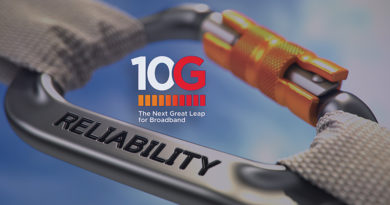Enabling the Next Wireless Generation
By Erik Gronvall
For years, mobile network operators (MNOs) have tried to deploy small cells to boost coverage and increase capacity. Deployments are limited because of the costs and MNOs end up going back to the macro site to increase capacity. The cost issues involve power, backhaul and location; however, with 5G, there is now a need to move to a more densified network and cable operators have all the components available to help MNOs deploy these networks.
MNOs are facing a key problem as it relates to operating the wireless network. The amount of data provided has continued to grow at an exponential rate while the average amount paid for wireless access has only increased slightly. This drives a need to increase efficiency in deploying wireless services. There are three main challenges in deploying a cell site: power, backhaul, and site acquisition.
Each of these has hindered the widespread use of small cells in the past and a more economical solution found for 5G to succeed in the future.
Power
Wireless network planners have traditionally used grid power from the local utilities to power their network infrastructure. When deploying macro sites, one may assume that grid power will be available at the pole or tower. To access this power, the telco receives a permit from the utility to deliver power to each site.
Cost and time-to-market issues associated with large, ultra-dense small cell deployments taking place in cities and suburbs make the grid power approach impractical. Telcos might not have the manpower for all the deployments and it might take years to acquire the necessary permits. Also, with telcos paying between $5,000 and $15,000 per cell in small deployments, they will not spend that much when they must deploy small cells in the thousands.
Another issue with power is how to deliver it. For more than four decades, the cable television industry has used coaxial cable. This same coaxial cable that is used to transmit a television signal or connect to the Internet is also used to transmit power to cable network equipment. The same coaxial cable can also be an efficient method to deliver power to new small cell deployments. In fact, up to 90 volts AC and 15 amps can be carried on the coaxial cable. This can provide some serious CapEx and OpEx savings to the telco because it can be used as a conduit for delivering power with optical fiber being used as the backhaul/fronthaul media.
The need to solve the power delivery problem for small cells is real, to the point where new, innovative systems are being developed to meet the demand. These include higher voltage, higher power delivery systems that make use of new, higher-gauge copper conductor installation or a daisy chained solution. All are designed with safety in mind.
Backhaul
The new centralized cloud radio access network (C-RAN) deployments bring different requirements on the backhaul network as the base band unit is being moved from the site to centralized locations. This cloud RAN creates three types of backhaul with different demands: fronthaul, midhaul, and backhaul.
While dark fiber can be used in each area and is often the preferred method for MNOs, other technologies can be leveraged with the hybrid fiber/coax network to provide front, mid, and backhaul to small cells. Wavelength division multiplexing (WDM) technology can be used to optimize the fiber used in front, mid, and backhaul. Cable operators are more familiar with WDMs and able to track the wavelengths better throughout their network. In some midhaul applications passive optical network (PON) or DOCSIS can be leveraged. Even more applications for backhaul can use PON or DOCSIS. The cable community has fiber and coax in appropriate places to be able to provide the connectivity to cell sites.
Site Acquisition
Cable operators have access to many of the poles and other sites; however, there are solutions that place radios and antennas on the top of poles. There are also smaller radios that are capable of being placed on the strand simplifying the deployment process further. In locations where the plant is underground, other solutions can be leveraged to provide the vertical height for mounting antennas. Considerations include integrated light poles and active equipment cabinets. Either way, the cable community has vast experience in working with municipalities in siting equipment in the outside plant.
The drive to 5G is underway and the networks operated by the cable community contain advantages in deploying small cells for the 5G and 4G densification. The challenges in deploying small cells can be solved by using existing plant provided by the cable community.
Erik Gronvall is Vice President of Service Provider Strategy and Network Architecture for the Americas for CommScope. Erik joined CommScope through the acquisition of TE Connectivity’s Broadband Network Solutions (BNS) businesses in August of 2015. Collectively, Erik has served TE and ADC for more than 10 years – leading product strategy, design and development for inside and outside plant connectivity solutions. Erik holds multiple patents on network architectures and product designs and provides regular consultation to customers on outside plant connectivity requirements. Erik holds a Bachelor of Science degree in chemical engineering from the University of Minnesota and an MBA at the University of St. Thomas.




